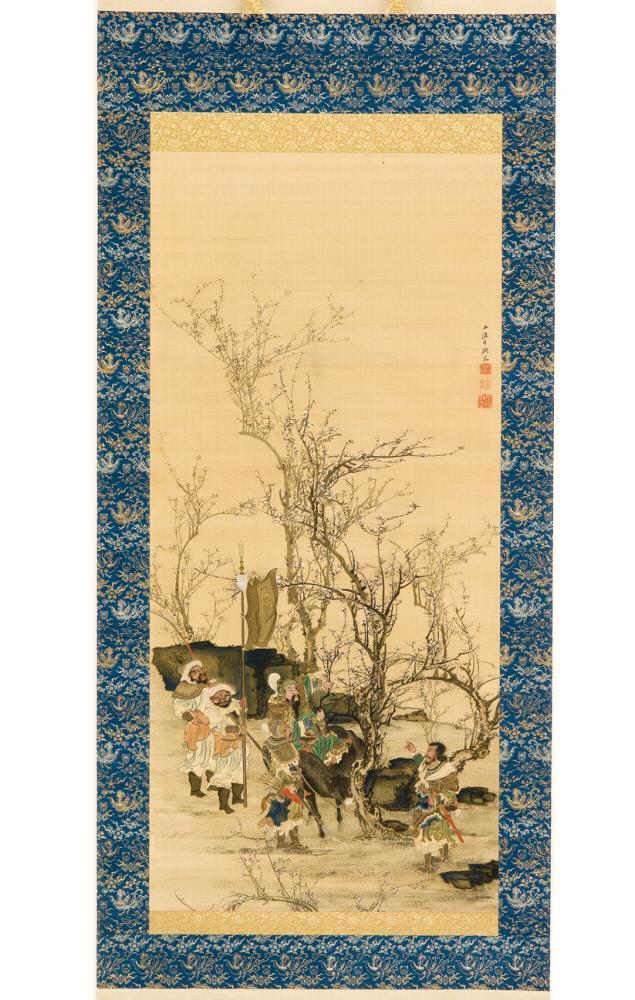Three Heroes of the Peach Blossom Garden
Now that HoMA is reopening, this is a good time to thank the Hawai’i community for its support and loyalty during the last few months. One of the paintings now on display in the Japan Gallery has loyalty as its subject: Hazama Seigai’s Three Heroes of the Peach Blossom Garden.

Three Heroes of the Peach Blossom Garden
Hazama depicts a celebrated meeting of friends in China from many centuries earlier. The friends were Liu Bei (161–223, carrying a quiver of arrows), Zhang Fei (d. 221, holding a sling) and Guan Yu (d. 219, wielding a halberd). The story goes that the three met during a time of upheaval, when the long stability of the Han dynasty (202 BC–220 AD) was finally at an end, and the country was overtaken by a popular insurgency led by a sorcerer of terrifying power. In a garden of blossoming peach trees, they pledged to stand together against the evils of their age, going forward as brothers-in-arms who might not have been born together, but would die together. They were not able to save the dynasty, but Liu—himself a descendant of Han royal family—gathered together loyalists of the fallen empire and had a number of military victories, establishing his own state in southwestern China, where he managed to rule for more than a decade. Zhang Fei fought in many battles with Liu, gaining a reputation as a fierce (if unstable) warrior, but was assassinated within a year of the founding of Liu’s kingdom. Guan Yu, ever steadfast in his oath, served Liu until he was eventually betrayed by a rival ruler, who had him executed. Although the three did not manage to die together, their faithful friendship in the face of insurmountable adversity became the stuff of legends.
In fact, the meeting in the Peach Blossom Garden—and the oath that was made there—probably never actually took place. The source for the story is a 14th century novel, Romance of the Three Kingdoms, written by Luo Guanzhong (c. 1330–1400). By Luo’s time, Guan Yu was no longer seen as a mere mortal, but had ascended the ranks of the gods to become Emperor Guan, the patron deity of warriors and merchants. Even today, he is by far the most popular god in the entire Chinese pantheon. Zhang Fei was similarly deified (but as a more minor deity), and Liu was transformed from a brief ruler of a minor state to a noble character of epically tragic stature. The author of Romance of the Three Kingdoms himself lived during a time of upheaval, born under foreign Mongol rule only to see that short-lived government collapse, and the three friends’ oath says more about Chinese resistance to the Mongols in the 14th century than the political instability of more than a thousand years earlier. And of course, if we were to set aside Luo’s highly romanticized storytelling—not to mention the more factually-based but still hardly neutral accounts of historians across the centuries—and examine the mechanisms of imperial power, military conflict, and “peasant” uprisings through a contemporary lens, we would likely come to a much different understanding of Liu, Zhang, and Guan, and the time in which they lived.
Nevertheless, once the story was told, it had a lasting impact. The novel was so popular that teachers complained of students wasting all of their time surreptitiously reading it instead of studying the Classics, and its influence spread beyond China’s borders across much of Asia. Later generations interpreted the Peach Garden Oath in light of their own circumstances, and the three men’s loyalty became not only a model of friendship, but also of righteous political resistance. Hazama Seigai lived to see the end of the last shogunate, which collapsed under both internal and external pressures—including the arrival of American warships in Edo Bay, forcibly opening the country after centuries of isolation. Although he studied painting in Kyoto, he was from Yamaguchi in western Japan, which was a hotbed of anti-shogunate activity, and played a key role in the restoration of the Meiji Emperor (r. 1867–1912). It is nearly impossible not to understand Hazama’s choice of subject as being influenced by the larger political movements of his time. The ideals embodied in the Peach Garden Oath also resonated deeply with the efforts to bring an end to Manchu rule and establish a modern government in China slightly later, in which the Hawaii Chinese community played a role through its support of Sun Yat-sen (1866–1925). The story remains one of the most influential expressions in world literature of the strength that comes from friendship and loyalty, with a new relevance for each generation and the challenges they face.
Hazama Seigai (1811–1878)
Three Heroes of the Peach Blossom Garden
Japan, 19th century
Hanging scroll; ink and color on silk
Purchase, 2005
(13184.1)